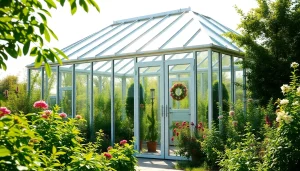Introducing Vertical Gardens
Vertical gardening, an innovative way to maximize space while greening urban environments, has gained immense popularity over recent years. As urbanization continues to rise, the need for spaces that offer both aesthetic appeal and environmental sustainability has become more crucial. This need is brilliantly met by vertical gardens, which transform walls, balconies, and terraces into vibrant green spaces. Understanding the concepts, benefits, and implementation of vertical gardens empowers urban dwellers to create their own patch of nature amidst concrete jungles.
What Are Vertical Gardens?
Vertical gardens, also known as living walls or green walls, refer to a method of growing plants on vertical surfaces. This technique can be employed in different settings, from indoor spaces to expansive outdoor areas. The primary goal is to cultivate a lush wall of plants that can enhance aesthetic value, promote biodiversity, and improve air quality.
Vertical gardens can utilize a variety of plants from succulents to flowering vines. They can be designed for decorative purposes or as functional gardens to produce herbs and vegetables. The components used for vertical gardening can range from sophisticated modular systems to simple DIY setups, making it accessible for everyone from seasoned gardeners to beginners.
The Gastronomy of Vertical Gardening
One of the most appealing aspects of vertical gardening is its potential to support food production within limited spaces. Urban gardening enthusiasts have turned vertical gardens into edible landscapes, growing an array of vegetables, herbs, and even fruits. Common edible plants include:
- Herbs such as basil, mint, and rosemary
- Vegetables like lettuce, spinach, and cherry tomatoes
- Fruits including strawberries and dwarf varieties of peppers
Implementing vertical gardening in urban gastronomy not only provides fresh produce but also creates a direct connection between city dwellers and their food source. This encourages sustainable living and fosters a deeper appreciation for gardening and cultivated ecosystems.
Benefits of Vertical Gardens in the Modern City
The benefits of vertical gardens extend beyond aesthetics and food production. They contribute significantly to urban ecosystems, provide numerous environmental benefits, and enhance the quality of life for residents:
- Space Optimization: Vertical gardens make use of the often-ignored vertical space in urban settings, maximizing growing areas without requiring additional ground space.
- Improved Air Quality: Plants are natural air purifiers; they absorb carbon dioxide and release oxygen while filtering airborne pollutants and toxins.
- Thermal Insulation: Vertical gardens can help regulate building temperatures, insulating walls against heat loss in winter and reducing heat absorption in summer.
- Noise Reduction: The plants serve as a sound barrier, reducing noise pollution in busy urban environments, creating calmer living spaces.
- Biodiversity Enhancement: By providing a habitat for various species, vertical gardens can significantly promote urban biodiversity, aiding in the preservation of pollinators and other wildlife.
- Aesthetic Appeal: Aesthetically, vertical gardens improve the visual landscape of cities, bringing a sense of tranquility and nature to urban life.
Design Ideas for Vertical Gardens
Planning and Selecting the Right Plants
Designing a vertical garden begins with planning and deciding which plants will be included. Here are key considerations for making optimal choices:
- Environment: Consider the amount of sunlight available, humidity, and temperature in the chosen location.
- Plant Selection: Choose plants that thrive in your local climate and growing conditions. Suitable options might include:
- For sunny areas: Succulents, herbs, and flowering plants like geraniums.
- For shaded areas: Ferns, ivy, and shade-tolerant flowering plants.
- Impact: Select plants that offer visual impact through varying textures, colors, and growth habits to create an engaging design.
- Maintenance: Consider ease of care; some plants may require more water or specific conditions than others.
DIY Vertical Garden Projects for Beginners
Creating a vertical garden can be a rewarding DIY project. By following simple guidelines and using readily available materials, anyone can embark on their gardening journey. Here are a few starter ideas:
- Pallet Garden: Utilize a wooden pallet to create a simple yet effective vertical garden. Landscape fabric can be added to hold soil and plants.
- Hanging Planters: Sourcing various hanging planters allows for a more eclectic design and can be easily rearranged as plants grow.
- Wall-Mounted Grids: Install wire grids or trellises on a wall and grow climbing plants for a stunning green display.
- Gutter Gardens: Repurposing old gutters vertical gardening allows for a unique way to showcase herbs or small flowers, whether outdoors or indoors.
Creative Solutions for Small Balconies
Small spaces shouldn’t deter anyone from creating a vertical garden. Here are creative solutions tailored for compact urban balconies:
- Modular Wall Systems: These systems come with pockets and grids to maximize vertical space while providing access to light and water.
- Vertical Planters: Stackable vertical planters can be ideal for growing herbs or vegetables while saving floor space.
- Balcony Rail Planters: Attach planters to the balcony railing to utilize this often-overlooked area effectively.
Care and Maintenance of Vertical Gardens
Watering Techniques for Vertical Gardens
Proper watering is crucial for the health of a vertical garden. Here are effective watering techniques:
- Drip Irrigation: Installing a drip irrigation system makes watering automated and ensures equal distribution across all plants.
- Watering Schedule: Regular checks to monitor moisture levels and adjust watering schedules can optimize plant health.
- Self-Watering Systems: Consider using self-watering planters that allow plants to draw water as needed, minimizing the chances of overwatering.
Pest Control in Vertical Plantings
Managing pests is essential in any garden setting. Vertical gardens can be prone to specific pests due to their proximity to walls and structures. Strategies for pest management include:
- Regular Inspections: Frequently check plants for signs of pests and disease to catch issues early.
- Natural Remedies: Instead of harsh chemicals, utilize natural pest deterrents such as neem oil or insecticidal soap.
- Companion Planting: Integrate pest-repelling plants with your vertical garden setup to deter unwanted visitors.
Optimal Nutrient Supply
Nutrients are vital for the growth and overall health of plants in vertical gardens. Here are key considerations for ensuring adequate nutrition:
- Soil Composition: Use well-draining soil mixes enriched with organic matter to facilitate nutrient uptake.
- Fertilization: Apply slow-release fertilizers to provide nutrients over time, considering each plant type’s specific nutrient needs.
- Plant Rotation: Rotate crops in edible vertical gardens to ensure soil health and nutrient balance.
Vertical Gardens as Part of Sustainable Urban Development
Ecological Benefits of Vertical Gardens
Integrating vertical gardens into urban landscapes yields numerous ecological benefits:
- Carbon Emissions Reduction: Urban greenery helps sequester carbon, mitigating climate change impacts.
- Stormwater Management: Vertical gardens absorb rainwater, reducing runoff and aiding in managing urban flooding.
- Heat Island Mitigation: Green spaces help reduce urban heat islands, thereby cooling cities during warmer months.
- Enhanced Biodiversity: Vertical gardens foster habitats for birds, insects, and beneficial microorganisms, improving urban ecosystems.
Integration into Existing Architecture
Architectural integration of vertical gardens offers both visual and functional advantages. Here are ways to combine vertical gardens with architectural designs:
- Facade Enhancements: Vertical gardens can be designed to blend seamlessly with building facades, creating visually stunning buildings.
- Green Energy Solutions: Consider integrating vertical gardens with solar panels, optimizing energy production and plant growth simultaneously.
- Public Spaces: Employ vertical gardens in public parks, green roofs, and urban plazas to enhance urban biodiversity and amenity value.
Case Studies of Successful Projects
Several cities worldwide have embraced vertical gardens as part of their urban landscape. Notable examples include:
- One Central Park, Sydney: This project features two iconic green towers adorned with vertical gardens that provide natural insulation and aesthetic beauty.
- The CaixaForum, Madrid: This cultural center showcases a striking vertical garden by Patrick Blanc, visually and environmentally enhancing the urban space.
- Hôpital L’Archet 2, Nice: France’s largest vertical garden adorns the hospital, improving air quality and patient well-being through nature integration.
Measuring the Success of Your Vertical Garden
Growth Monitoring and Adjustments
Successful vertical gardening requires ongoing monitoring of plant growth and health. Here are strategies to assess and improve your garden:
- Visual Inspections: Regularly assess plant vigor, colors, and overall health.
- Nutrient Testing: Conduct soil tests to check nutrient levels and amend accordingly.
- Adapting Techniques: Adapt watering, lighting, and care techniques based on observed plant responses.
Evaluating Aesthetic Impact
To assess the aesthetic success of a vertical garden, consider the following:
- Visitor Feedback: Gather opinions from passersby and residents; aesthetic value is often in the eye of the beholder.
- Color and Texture Analysis: Monitor seasonal changes in appearance, ensuring year-round visual appeal.
- Integration with Surroundings: Evaluate how well the garden fits into its surrounding environment, contributing positively to the overall landscape.
Long-term Planning and Sustainability
Planning for sustainable success extends beyond initial installation:
- Regular Maintenance Schedules: Develop and adhere to a maintenance routine to ensure plant health and vibrancy.
- Incremental Improvements: Continually assess and adapt the garden layout or plant choices to improve health and aesthetics.
- Education and Community Involvement: Foster community engagement through workshops, collaborating with locals to enhance understanding and appreciation of vertical gardening.







